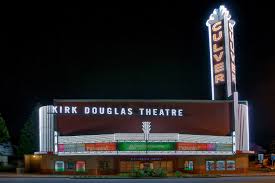
 The Board of Directors of the American Institute of Architects (AIA) voted February 9, 2015 for Ehrlich Architects to receive the 2015 AIA Architecture Firm Award.
The Board of Directors of the American Institute of Architects (AIA) voted February 9, 2015 for Ehrlich Architects to receive the 2015 AIA Architecture Firm Award.
Culver City knows Ehrlich best for his work on the Kirk Douglas Theater, but his work on Culver City is far from over. Two large-scale projects in the Downtown District are currently underway. Parcel B, located at 9300 Culver Boulevard, is a development that Mayor Meghan Sahli-Wells called “a key, place-making destination as well as a focal point for Culver City’s Downtown.” Ehrlich has also designed the Stoneview Nature Center, the transformation of a five-acre brownfield site into a highly sustainable nature center which will be completed in early 2016. Ehrlich. He will also be the featured at the next architechtureTALKS presented by the Culver City Cultural Affairs Foundation on Monday, February 23, 2015 at the Kirk Douglas Theater to discuss his work there. (Click here www.culvercity.org/en/Articles/ArchitectureTalks_022415.aspx for more information and tickets )
The firm will be honored at the 2015 AIA National Convention in Atlanta. Ehrlich Architects is renowned for fluidly melding classic California Modernist style with multicultural and vernacular design elements by including marginalized design languages and traditions.
The AIA Architecture Firm Award, given annually, is the highest honor the AIA bestows on an architecture firm and recognizes a practice that consistently has produced distinguished architecture for at least 10 years.
The work of Ehrlich Architects covers a wide variety of program types (residential, commercial, institutional, educational) and uses a much richer palette of materials and textures than the typical California Modernist-influenced firm. However, they are most distinguished by the subtle and complex way they blend Modernist and multicultural design elements.
Before founding his Los Angeles-based firm in 1979, Steven Ehrlich, FAIA, spent time working with the Peace Corps in Africa. There Ehrlich gained an appreciation for simple, natural materials and vernacular solutions to energy, sustainability, and building performance challenges. Back in Southern California, Ehrlich found opportunities to renovate properties designed by architects high up in the California Modernist canon (like Richard Neutra, FAIA), which helped him to develop a confident, loose-limbed, but still traditional Modernist aesthetic. But his experiences in Africa, with building traditions created years before Modernism demanded a total rupture with the past, pushed him to develop an architecture that was more inclusive, responsible, and responsive than pure Modernism.
Ehrlich Architects is led today by four diverse partners whose personal backgrounds and experiences result in a unique cultural sensitivity and a commitment to creating architecture that is globally relevant. They are: Steven Ehrlich, FAIA; Takashi Yanai, AIA; Patricia Rhee, AIA; and Mathew Chaney, AIA.
To fulfill these goals, Ehrlich Architects see themselves as “architectural anthropologists”—exploring ancient, developing-world building traditions and situating them in contemporary buildings to solve contemporary problems. Japanese-style courtyards, Middle Eastern lattice screens, and vernacular mud construction have all been ways they enrich contemporary architecture with age-old multicultural building elements.
“The marriage of the particular with the universal is one of the great virtues of the firm’s design approach, where connections between culture, climate, people and place are woven together in a distinct humanistic architecture shaped by circumstance,” wrote Steve Dumez, FAIA in a letter of recommendation.


Be the first to comment